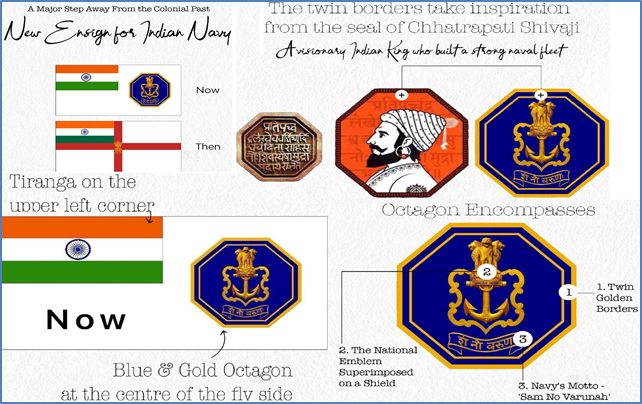In News:
- PM Modi recently unveiled the Indian Navy's new ensign in Kochi, on the occasion of the commissioning of INS Vikrant, the country's first Indigenously Aircraft Carrier (IAC-1).
What’s in today’s article:
- About the Indian Navy’s Ensign
The Indian Navy’s Ensign:

- About a Naval Ensign:
- As the name suggests, a naval ensign is a flag that is installed atop naval warships, on ground stations, at air bases and other institutions used as a form of maritime identification.
- Indian naval ensign is also known as 'Nishaan' meaning symbol.
- Every country's navy has its own ensign which can be the same as their country's flag or a distant one. For example, the US Navy's ensign is the same as its national flag.
- Tracing the history of India’s Naval Ensign:
- The existing ensign of the Indian Navy draws its origin from the colonial past.
- On October 2, 1934, the naval service was renamed Royal Indian Navy (RIN), with its headquarters at Bombay (now Mumbai) and the ensign also changed to the one used by the Royal Navy till 1950.
- From 1950 to 2001, the navy's ensign was the St George's Cross - red cross on a white background, with the national flag in the upper canton before it was changed in 2001.
- The Saint George’s Cross is named after a Christian Warrior Saint who is believed to have been a crusader during the third crusade.
- This cross also serves as the flag of England which is a constituent of the United Kingdom.
- The Red George's Cross was retained by most Commonwealth countries at the time of gaining independence, but several (Australia, New Zealand, and Canada are prominent among them) have removed it by their separate navy ensigns over the years.
- Between 2001 and 2004, the Indian Navy adopted an Indianised ensign that showed only the Indian flag and the navy crest, bringing in commonality with the flags of the Indian Air Force and Indian Army (the Army and Air Force adopted their current ensigns in 1950).
- In 2004, the Indian Navy returned to its pre-2001 ensign with the addition of the state emblem placed at the intersection of the cross.
- The next change in ensign came in 2014 when "Satyamev Jayate" were placed under the national emblem at the centre of the St George's Cross.
- The new Ensign and its significance:
- The new ensign now features the national emblem (encircled by an octagonal shield and sitting atop an anchor) with the Tricolour on the upper canton (top left corner of the flag).
- The Saint George's Cross has been removed from the Indian Navy's new flag in an effort to distance itself from its "colonial past."
- Beneath the anchor is the Navy’s motto ‘Sam No Varunah’ (Oh Varuna, be auspicious to us).
- The golden border surrounding the national emblem draws inspiration from the seal of Indian emperor Chhatrapati Shivaji Maharaj and depicts steadfastness.
- Chhatrapati Shivaji Maharaj placed a high priority on maritime prowess, laying the foundation for a modern naval force in the 17th century.
- Kanohji Angre (the Maratha Navy commander) led the Maratha navy and is credited with creating a solid naval foundation that assured the Marathas were a maritime power to be reckoned with.
- The Indian Navy has always recognized these facts, naming a training facility in Lonavla as INS Shivaji and a shore-based logistics and administrative centre of the Western Naval Command in Mumbai as INS Angre.
- The octagonal shape of the national emblem has been designed to represent eight directions, symbolising the multi-directional reach and multi-dimensional operational capability of the Indian Navy.









